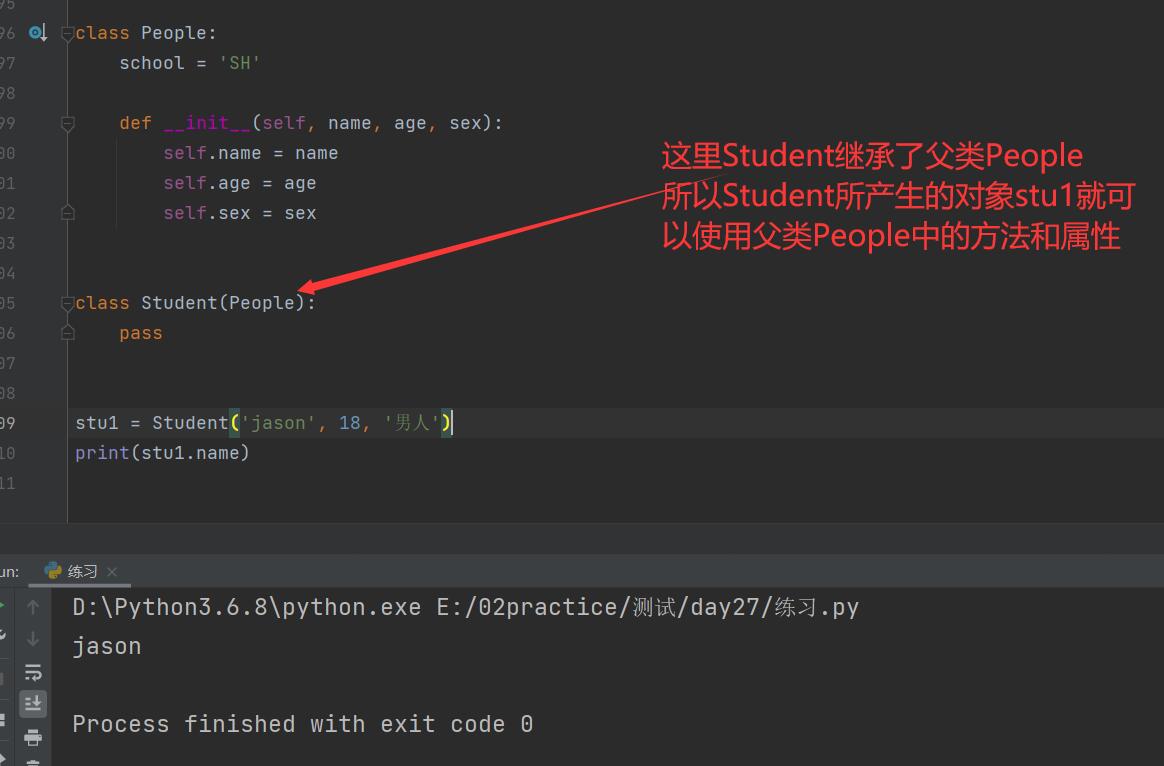面向对象之继承与多态
一. 继承(重要)
1.1 概念
-
什么是继承?
继承就是新建类的一种方式,新建的类我们称为子类或者叫派生类,被继承的类我们称为父类或者基类,子类可以使用父类中的属性或者方法
-
为什么要用继承?
类解决了对象与对象之间的代码冗余问题
继承解决的是类与类之间的代码冗余问题
-
如何使用继承?
新式类:继承了object类的子子孙孙类都是新式类
经典类:没有继承了object类的子子孙孙类都是经典类
ps:新式类和经典类只有在python2中区分
1.2 类的继承

1.3 单继承下属性查找
class Foo:
def f1(self):
print('Foo.f1')
def f2(self):
#
print('Foo.f2')
self.f1()
class Bar(Foo):
def f1(self):
print('Bar.f1')
obj = Bar() # {}
obj.f2()

练习:
class Foo:
def __f1(self): # _Foo__f1()
print('Foo.f1')
def f2(self):
print('Foo.f2')
self.__f1() # _Foo__f1()
class Bar(Foo):
def __f1(self): # # _Bar__f1()
print('Bar.f1')
obj = Bar()
obj.f2()

1.4 多继承下的属性查找
bases用法:
print(类名加_ _ bases _ _) 是查看该类所有的父类


# 新式类:按照广度优先查询
# 经典类:按照深度优先查询
class A(object):
def test(self):
print('from A')
class B(A):
# def test(self):
# print('from B')
pass
class C(A):
# def test(self):
# print('from C')
pass
class D(B):
# def test(self):
# print('from D')
pass
class E(C):
# def test(self):
# print('from E')
pass
class F(D, E):
# def test(self):
# print('from F')
pass
f1 = F()
f1.test()
1.5 super()
作用:super( ) 是调用父类的属性或方法
super()的应用场景:
子类可以派生出自己新的属性,在进行属性查找时,子类中的属性名会优先于父类被查找,我们既想使用父类的属性, 又想赋予子类新的属性,这时就需要使用super().

查找顺序也遵循mro列表
1.5 mro列表(了解)
对于你定义的每一个类,Python都会计算出一个方法解析顺序(MRO)列表,该MRO列表就是一个简单的所有基类的线性顺序列表,如下:
# mro列表练习2
class B:
def test(self):
print('B---->test')
def aaa(self):
print('B---->aaa')
class A:
def test(self):
print('A---->test')
super().aaa()
class C(A, B):
def aaa(self):
print('C----->aaa')
c = A()
# c.test() # 打印结果:
print(A.mro())

三. 组合
在一个类中以另外一个类的对象作为数据属性,称为类的组合。组合与继承都是用来解决代码的重用性问题。不同的是:继承是一种“是”的关系,比如老师是人、学生是人,当类之间有很多相同的之处,应该使用继承;而组合则是一种“有”的关系,比如老师有生日,老师有多门课程,当类之间有显著不同,并且较小的类是较大的类所需要的组件时,应该使用组合,如下示例
class Course:
def __init__(self,name,period,price):
self.name=name
self.period=period
self.price=price
def tell_info(self):
print('<%s %s %s>' %(self.name,self.period,self.price))
class Date:
def __init__(self,year,mon,day):
self.year=year
self.mon=mon
self.day=day
def tell_birth(self):
print('<%s-%s-%s>' %(self.year,self.mon,self.day))
class People:
school='清华大学'
def __init__(self,name,sex,age):
self.name=name
self.sex=sex
self.age=age
#Teacher类基于继承来重用People的代码,基于组合来重用Date类和Course类的代码
class Teacher(People): #老师是人
def __init__(self,name,sex,age,title,year,mon,day):
super().__init__(name,age,sex)
self.birth=Date(year,mon,day) #老师有生日
self.courses=[] #老师有课程,可以在实例化后,往该列表中添加Course类的对象
def teach(self):
print('%s is teaching' %self.name)
python=Course('python','3mons',3000.0)
linux=Course('linux','5mons',5000.0)
teacher1=Teacher('lili','female',28,'博士生导师',1990,3,23)
# teacher1有两门课程
teacher1.courses.append(python)
teacher1.courses.append(linux)
# 重用Date类的功能
teacher1.birth.tell_birth()
# 重用Course类的功能
for obj in teacher1.courses:
obj.tell_info()
三. 多态与多态多样性
1. 什么是多态
水:液态水,固态水,气态水
动物:人,猪,狗,猫 ...
# 抽象类: 抽象类只能被继承,不能被实例化
class Animal(metaclass=abc.ABCMeta):
@abc.abstractmethod # 该方法已经是抽象方法了
def speak(self): pass
@abc.abstractmethod
def login(self):pass
class People(Animal):
def speak(self):
# print('嗷嗷嗷')
pass
def login(self):
pass
class Pig(Animal):
def speak(self):
print('哼哼哼')
class Dog(Animal):
def speak(self):
print('汪汪汪')
obj = People()
obj.speak()
# 多态练习
class Pig():
def speak(self):
print('哼哼哼')
class Dog():
def speak(self):
print('汪汪汪')
class Txt():
def speak(self):
print('Txt')
obj = People()
obj1 = Pig()
obj2 = Dog()
obj3 = Txt()
# 多态带来的特性:在不用考虑对象数据类型的情况下,直接调用对应的函数
def animal(animal):
return animal.speak()
animal(obj)
animal(obj1)
animal(obj2)
animal(obj3)
# 父类限制子类的行为
class Animal():
def speak(self):
raise Exception("必须实现speak方法")



【推荐】国内首个AI IDE,深度理解中文开发场景,立即下载体验Trae
【推荐】编程新体验,更懂你的AI,立即体验豆包MarsCode编程助手
【推荐】抖音旗下AI助手豆包,你的智能百科全书,全免费不限次数
【推荐】轻量又高性能的 SSH 工具 IShell:AI 加持,快人一步
· 基于Microsoft.Extensions.AI核心库实现RAG应用
· Linux系列:如何用heaptrack跟踪.NET程序的非托管内存泄露
· 开发者必知的日志记录最佳实践
· SQL Server 2025 AI相关能力初探
· Linux系列:如何用 C#调用 C方法造成内存泄露
· Manus爆火,是硬核还是营销?
· 终于写完轮子一部分:tcp代理 了,记录一下
· 别再用vector<bool>了!Google高级工程师:这可能是STL最大的设计失误
· 单元测试从入门到精通
· 震惊!C++程序真的从main开始吗?99%的程序员都答错了